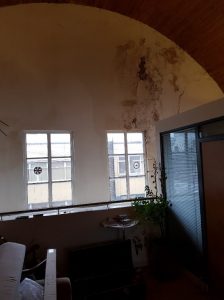We at LABS basements and damp proofing would like to share some of our top tips on how to spot damp walls, and the different types of damp that could be present.
Rising damp is perhaps the most commonly known form of damp that might affect your home. It tends to occur in older buildings, with no adequate damp proof course (DPC), when groundwater rises up through porous materials, such as the bricks and mortar that make up your walls.
A common signature of rising damp is a clearly defined band of dampness, starting at your floor and moving upwards, this will often cause your paint to start flaking, or wallpaper to peel. Damp walls that are caused by rising damp can also result in other symptoms such as:


These pictures show typical signs of rising damp and damp walls. The picture on the left picture shows moisture readings indicative of rising damp, along with visual signs such as the blistered plaster work. The picture on the right shows what a wall affected by rising damp might look like.
Penetrating damp occurs when water manages to find its way inside a property from the exterior. This can happen in a number of ways, such as ingressing through walls, windows, and door fittings. penetrating damp is more likely to arise as a problem in older properties, or those located by the sea or in open areas that are open to the elements. It is key to identify penetrating damp as quickly as possible otherwise it may evolve in to a larger issue, such as a rot infestation, or contaminated plaster.
Whilst some of the symptoms of penetrating damp, are similar to those of rising damp, the key differential between the two is usually found in the structural factors. Penetrating damp tends to occur as a result of structural issues, such as a failing guttering system, faulty roofing, or cracks and holes in external walls. Penetrating damp is one of the most common causes of damp walls.
These are some telling signs of penetrating damp


Importantly dampness around the chimney can be often misdiagnosed as a problem with the chimney stack. More often than not this problem can be attributed to the fossil fuel residue left by coal, coal contains salt minerals such as nitrates, chlorides and sulphates that can migrate from the brick work through to the plaster finish. When in the plaster finish, these salts draw moisture from the environment to them and will show up with wet patches with no uniformity in presentation.
The problems with damp chimney walls are alleviated in a similar fashion to other damp problems. chimneys are also prone to other causes of dampness, such as; open or broken chimney pots, poorly-constructed chimney stack/lead fleshing, ventilation and cracked mortar around the chimney stack. It is important to note that rising damp can also lead to chimney damp if left untreated.
Here are some ways to tell if you have a chimney damp problem, and these can be at any section of the chimney breast throughout a given property.

This picture shows a clear damp patch just below the dado decorative rail.